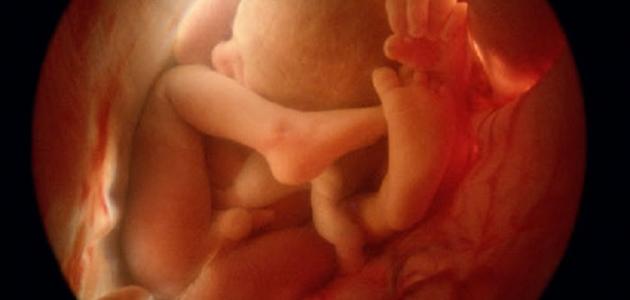Contents
Fetal growth stops
Fetal growth stunting, or what is known as intrauterine growth restriction, is a term describing the stage of abnormal growth of the fetus inside the womb, and a third of young children at birth are considered to have stunted growth at some stage of pregnancy , while the rest of the children Babies at birth are not affected by stunted growth, but their size is smaller than normal, and young children whose growth has stopped at one stage of pregnancy are more vulnerable to many risks, such as: difficulty tolerating the stress of vaginal birth, and the risk of stillbirth increases for them, and a low level of sugar in Their blood at birth, abnormally high red blood cell count , and their inability to maintain their own body temperature. [1]
Causes of fetal stunted growth
Fetal stunted growth occurs in many cases as a result of a problem that prevents the child from getting enough oxygen and nutrients that help the child to grow due to several reasons, but placental insufficiency is the common cause, so that the tissues that deliver oxygen and nutrients to the child do not It works properly [2], and there are a group of factors that lead to a stunted growth of the fetus, such as: [3]
- Maternal factors: Factors associated with the mother, which increase the risk of developing fetal stunted growth, include the following:
- Malnutrition in the mother during pregnancy .
- Small size of the mother.
- An abnormality in the blood flow to the placenta.
- Conditions that affect the mother’s blood vessels, such as: high blood pressure, blood poisoning , preeclampsia , and diabetes.
- The abnormal shape or size of the mother's uterus.
- Infection of the mother with chronic, long-term diseases.
- Genetic factors: The genetic factors that increase the risk of developing fetal stunted growth include the following:
- Defects associated with a fetus, such as: an abnormal heart.
- Chromosomal abnormalities, and genetic errors that lead to the development of a number of types of syndromes that lead to the occurrence of small size of the head of the fetus.
- Environmental factors: Environmental factors that exist outside and inside the uterus, and lead to a stunted growth of the fetus, include the following:
- Smoking or drug abuse by the mother.
- Multiple fetuses in a single pregnancy.
- An infection transmitted from the mother to the fetus via the placenta.
- Decreased oxygen and nutrients that reach the fetus due to defects associated with the umbilical cord and placenta.
Types of fetal stunted growth
There are two main types of fetal stunted growth: [4]
- Primary Intrauterine Growth Restriction: Initial intrauterine growth restriction is characterized by the small size of the internal organs of the fetus, and primary fetal stunting accounts for 20-25 percent of fetal stunts.
- Secondary Intrauterine Growth Restriction: Secondary fetal growth stunting is characterized by the size of a normal head and brain, except that the size of the abdomen is small.
Diagnosis of fetal growth stunted
Prenatal examinations help to confirm the growth of the child well during pregnancy, so that the size of the child is estimated in a number of ways, such as: Increasing the weight of the mother, as constant weight gain is an evidence of the growth of the fetus, and the height of the bottom is another method that helps determine the growth The fetus, so that the doctor measures the distance from the top of the pubic bone to the bottom of the uterus, as the distance must be equal to the number of weeks of pregnancy after the twentieth week, for example the height of the bottom must be 24 cm after 24 weeks of pregnancy, and there are many other diagnostic methods for stopping Fetal growth, such as: [5]
- Ultrasound of the fetus: Estimating the weight of the fetus using ultrasound is one of the best methods of diagnosing fetal stunted growth, and ultrasound is used to create images of the child inside the womb, and ultrasound diagnosis depends on the difference between the actual and expected measurements of the fetus at a certain age during pregnancy, and from It is worth noting that there is no negative effect of ultrasound on the fetus or the mother.
- Ultrasound : (Doppler ultrasound) The principle of ultrasound planning is to use a special type of waves that help determine the efficiency of blood flow through the placenta and the umbilical cord to the fetus, so that the decrease in blood flow indicates that the fetus is suffering from stunted growth .
Fetal stunted growth treatment
Although there is no cure for fetal growth stunting, some therapeutic methods may help slow the stunted growth of the fetus, or reduce its effect, and treatment is determined based on the medical history, the general health of the mother, and sensitivity to a certain type of medicine , including treatment methods As follows: [6]
- Nutrition, studies have shown that increasing the mother's nutrition during pregnancy may increase the growth of the fetus.
- Childbirth.Early labor may be the best option if there is a threat to the life of the fetus due to stunted growth.
- Rest. Bed rest at home or hospital improves the blood circulation of the fetus.
Prevention of fetal stunted growth
The mother can follow a set of measures that will help prevent exposure to fetal growth stunted, such as: [7]
- Keeping all appointments with the doctor before childbirth, as this allows problems to be detected and treated early.
- Visiting the doctor in the event that a change in the movement of the fetus is noticed , and a doctor should be consulted to check the side effects of the medicines that the mother is taking.
- Maintaining good health by eating healthy foods and calories that help keep the fetus nourished well.
- Get plenty of rest so that rest helps the fetus to develop.
- Adopting a healthy lifestyle by quitting smoking, drinking alcohol , and consuming drugs.
References
- ↑ "Intrauterine Growth Restriction" , familydoctor.org , Retrieved 24-5-2019. Edited.
- ↑ "Intrauterine Growth Restriction (IUGR)" , kidshealth.org , Retrieved 24-5-2019. Edited.
- ↑ "Intrauterine Growth Restriction" , www.magicfoundation.org , Retrieved 24-5-2019. Edited.
- ↑ "Intrauterine Growth Restriction (IUGR); Small For Gestational Age (SGA)" , americanpregnancy.org , Retrieved 24-5-2019. Edited.
- ↑ "Intrauterine Growth Restriction (IUGR)" , www.stlouischildrens.org , Retrieved 24-5-2019. Edited.
- ↑ "Intrauterine Growth Restriction (IUGR)" , www.stanfordchildrens.org , Retrieved 24-5-2019. Edited.
- ↑ "Intrauterine Growth Restriction (IUGR)" , www.webmd.com , Retrieved 24-5-2019. Edited.






